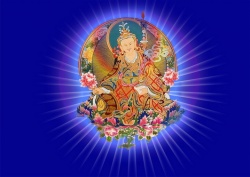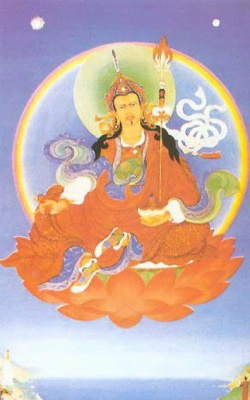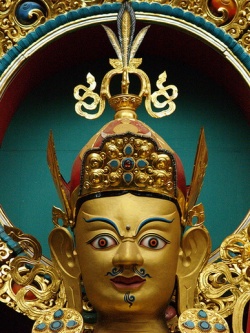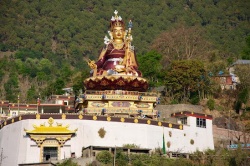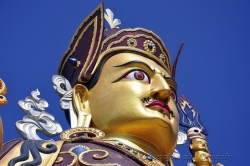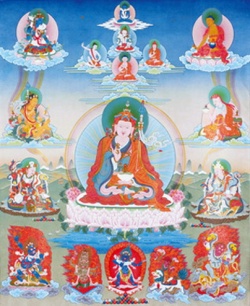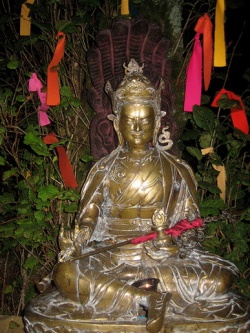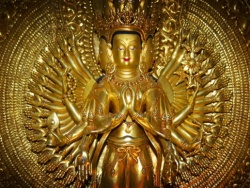The Root Guru
By Khentin Tai Situ Rinpoche
What exactly Is a "Tsawe-Lama"or "Root-Guru"?
There are several forms of Tsawe-Lama but we need only discuss the two most important ones here. The first form of Tsawe-Lama is the head of the particular school of Tibetan Buddhism that you are considering joining. The heads of that school can be traced right back for many centuries and this is called "The Lineage".
The head of the Karma Kagyu School of Tibetan Buddhism is His Holiness, Urgyen Trinley, the XVII Gyalwa Karmapa. You could say that the heads of the schools hold a similar position to that of the heads of the Christian orders of the Benedictine or Franciscan monks. The second form is
the Lama (who may or may not have the title of Rinpoche) under whose guidance you feel you can learn most and travel furthest. It Is someone for whom you have total respect; the person you turn to in need; someone you can follow without doubt or hesitation - whose words "enter your bones". It
is the person who helps you most to realise the true nature of your mind. This Tsawe-Lama wll be your strongest connection with the Dharma.
What does the phrase "true nature of your mind' mean?
It means your "Buddha-nature". It Is the essence of the Buddha, the innate goodness, which lies within every sentient being. It is the revelation of the supreme qualities of compassion and wisdom.
What is the difference between a Tsawe-Lama and any other Lama or teacher?
You can learn, or should be able to learn, something from any Lama; indeed from any person and every situation. However, you will learn more from your Tsawe-Lama than from any other.
The contact will be deep and will last for the rest of this life. It may have lasted for many lifetimes already and the connection will probably continue for many lifetimes to come. "Tsawe-Lama" is sometimes translated as "spiritual friend" or "spiritual guide" because he or she will be your main guide along the path of Dharma.
Is your Tsawe-Lama the Lama you take Refuge with?
Not necessarily. We call this Lama your "Refuge-Lama". The Refuge-Lama is the one who opens the door of the Dharma and introduces you. That Lama may become your Tsawe-Lama but only time will tell.
How does someone go about finding their Tsawe-Lama? How do you recognise him or her?
Have patience. Follow the advice of your Refuge-Lama. Practise diligently. Go to teachings when possible and the situation will become clear.
Is it possible to have a woman Tsawe-Lama?
Of course, why not?
Once someone has found their Tsawe-Lama does this mean they should not attend teachings or initiations given by other Lamas?
No, of course not, but a little care should be taken. Each tradition of Buddhism, such as Zen or Theravadin, and each school of Tibetan Buddhism has a different way of presenting things. If you listen to a great variety it is easy to confuse issues without
realising you are doing so. It is like a paint box! The red is a nice colour, and those two greens are both clear and bright, and the yellow and that rich purple - all are fine colours but if you mix them all together you get a muddy brown! It is better to stay with teachers of the same lineage as far as you can so that your mind does not become muddy brown! However, a little of one colour added to another can be good. Ask your Refuge Lama or your Tsawe-Lama for advice.
It is said that there is a strong connection between the student and their Tsawe-Lama and that the student should offer uncritical obedience. Is this correct?
Yes, there is a strong connection or bond between the Tsawe-Lama and the student but the student will offer what he or she can. Some students learn more by simple acceptance; others learn more by asking questions. Both are good. This is not the army! The role of the Tsawe Lama is to bring you to know the true nature of your mind-to see the truth as it is - not to brain-wash you.
If someone learned that their Tsawe-Lama had behaved in a manner contrary to their own moral standards, is it possible for that student to break the bond and find another Tsawe-Lama?
The student should remember that the bond is voluntary and it is possible that that Lama is no longer appropriate. Perhaps it was not their true Tsawe-Lama so in that case there was no bond to start with. If the Tsawe-Lama should break his own personal Samaya
(deep vows) then that dissolves the "contract" with the student and there is no longer a bond to break. If the student is unsure or uneasy then they should try to discuss the issue with their Tsawe- Lama, or with another Lama whom they respect - perhaps their Refuge-Lama. There may be a misunderstanding and an easy explanation. Time and common sense will show the way. If this is not possible, or if the student is still distressed, they should turn to their own Buddha-nature for guidance.
Questioner:
Tibetan Lamas and Dharma practitioners consider the root Guru very sacred. Please explain the characteristics and qualities of a root Guru.
Answer:
I’ve been thinking I should explain that. It is good that you asked today. Our interpreter is good so I think it will be beneficial to make some comments on this subject. What is called the root Guru is really very important, not just for Tibetan Buddhist practitioners but for all practitioners of Mahayana Buddhism. But before taking on a root Guru it is important to educate yourself as to what sort of qualities are necessary and what characteristics and conditions must be present. The previous Gurus have said,
First be skilled in checking the Lama.
Then be skilled in accomplishing the Lama.
Finally be skilled in training as he intends.
Even Buddha did not say that one should accept his teachings and teachers as good without checking them. He repeatedly said to examine them:
O Bhikshus and scholars!
Well examine what I teach,
Like gold that is checked by burning, cutting, and polishing it,
Only then accept it, not [just] out of veneration!
First, as explained in the Sutra collection, the Lama should have the following sorts of qualities. Regent Maitreya said,
The Spiritual Guide should be pacified, subdued, fully pacified,
Have more qualities, perseverance, be rich in scriptural knowledge,
Have fully realized ultimate truth, be skilled in speaking,
Have a loving nature and not get discouraged.
At best they should have all eight of those qualities. If that is not possible, Shantideva said,
Always, the Virtuous Spiritual Friend
Should be well versed in the meaning of the Mahayana,
And never give up, even for the sake of his life,
The supreme conduct of the Bodhisattvas!
Thus, the Lama should be a scholar of the Mahayana Bodhisattva collection of scriptures who never gives up bodhichitta even for the sake of his life. That is the sort of nature that is indispensable for a Lama. In the practice of Tantra, for a Vajra Master, in addition to those qualities, they should be well versed in the nature and scriptural system of the Tantras, have mastered the instructions of generation and completion stages, etc, have confidence of the view,
not be disordered in Tantric ritual such as the supreme victorious activity, and they should be endowed with discriminating wisdom and a vast minded nature. So how should one identify who is ones root Guru In the context of Sutra it is the one who gives you any one of the seven types of Pratimoksha vow and explanations of Dharma. Referred to as abbot and master in Sutra rather than the‘root Guru’, it is identifying the same relationship.
In Sutra it is said,
Having heard just one verse from someone,
If one doesn’t hold them as ones Lama,
Having taken rebirth a hundred times as a dog,
One will then take rebirth as a butcher!
Thus, it is said.
In the context of Tantra, we call the root Guru the one who gives the initiation which ripens your unripened mind, the transmission, which provides support, and the commentary which liberates your mind, that is, shows you what to adopt and what to abandon. Anyone who has given those three to you, regardless of how famous they are, you must consider then truly as a Lama who has shown you the three kindnesses. In particular, this also includes one who introduces the true nature of your mind to you, although
that is greatly diminished in number these days. Why is that? In these times of the five degenerations, it is extremely rare to find either a Lama or a disciple who is ready to introduce or be introduced to the true nature of their own mind from the very beginning without need for any other preparatory study or contemplation, etc. If it does happen, there is no kindness greater than
that! That kind root Guru who has such qualities, you should cherish as your life! Whether you abandon obscuration and attain realized qualities or not, whether you attain enlightenment or not, all such good things depend upon the root Guru. The root Guru is extensively praised with such names as the ‘wish-fulfilling treasury of omniscient wisdom’, and the ‘peerless lord
ornament of liberation’. These days there is a lot of trouble among westerners between lamas and disciples. That is the fault of not being able to examine the lama. It is very important to first examine the lama. Otherwise, without examining, running to someone because of name and gain and taking whatever initiations and vows, pratimoksha, bodhisattva, and tantric, that they
give, like a dog immediately gobbling down fresh meat, then bowing to them and venerating them as your ultimate refuge for this and future lives, loudly proclaiming to one and all, this is my lama, these are
my disciples, and then after things don’t work out after a few months, giving up all regard for the initiation commitments and so forth, then denying the lama and making fun of them, etc. this plants the seeds for hell and is something deeply regrettable. As Jamgon Lodro Taye said,
The Lama, true Buddha appearing, is perceived as a human being.
We forget the Guru’s kindness in revealing the profound instructions to us.
When things don’t go as we wish, meditate on conviction!
We’re obscured from seeing what they are doing by doubt and mistaken views!
Whether or not they are famous and have high position or not, if they are someone who, through teaching us holy Dharma, conferring initiation and so forth, has brought the benefit of Dharma to our mind, we can also call them our root Guru. When you say root Lama, don’t think that you are sort of abandoning the lamas of other traditions such as the Sakya,and
Gelug! Just like the branches and leaves of a tree all grow from the tree itself, all of the lamas from whom you have received Dharma and initiations are as if emanated from the [[root [Guru]] as the source. Likewise, the essence of the Yidam is the
root Guru. Although you meditate upon a Deity in whatever aspect, the previous adepts and masters have said that if you think of the Deity as inseparable from the Guru, it is a special condition for the arising of blessings and spiritual attainments.
Without having a Guru, whatever study and contemplation, meditation and practice, recitations, or other virtuous practice is undertaken will not bring liberation from samsara. As said in Tantra,
Without someone wielding the oars,
The ferry will not cross the river.
Though ones knowledge is complete,
Without a Lama it won’t free you from samsara.
These days, the attitude of most Asian people is that the root Guru must definitely be an incarnate Tulku who they consider very precious. Not only that, some Malaysians, Singaporeans, Taiwanese and so forth are delighted to have a guru who is a good-looking young Tulku who dresses up in rich brocade! But an ordinary monk who doesn’t
have name and fame who acts ordinary but practices holy Dharma in accordance with Buddha’s Teachings, who has contentment and few desires, they throw away as easily as a stone found on the road, disparaging and using them. At this time when even Dharma practitioners rush to act hypocritically, to say much about it disturbs my heart. So, recognizing this, disciples,
please be careful. These days there have been some Chinese people who studied Buddhism for a month or so and without receiving any explanation on mind training or anything, after having looked at a couple of small books, declared that they understood
everything and became arrogant about their wisdom and learning. Puffed up with pride, they criticized other Dharma practitioners, lamas and monks, secretly denying them and so forth, while teaching Dharma to those as silly as themselves, crowing that they must be a Tantrika or Rinpoche! When people are proud of their learning and practice and
see themselves as highest of all, it is a sign that they have not trained and controlled their mind through the common preliminaries of Dharma practice such as refuge. As the great scholar mahasiddha Chagme Raga also said,
Looking down on Refuge vows,
They say they are modern day mahasiddhas!
Though they fill the world with their claims,
I see no signs of goodness or excellence!
What he is saying is that there are some people who, without even having refuge vows, say they are a modern mahasiddha, giving prophecies and showing miracles, but if you check closely, it is the ‘blessings’ of mara and doubtful that it is any attainment of the Yidam Deity! In short, among all the teachings of Sutra and Tantra, there is nothing that
surpasses refuge for its vastness yet ease of practice, so if you would like to be a qualified Dharma practitioner who considers future lives to be of foremost importance, I would ask you to practice refuge and not consider it to be something insignificant.
